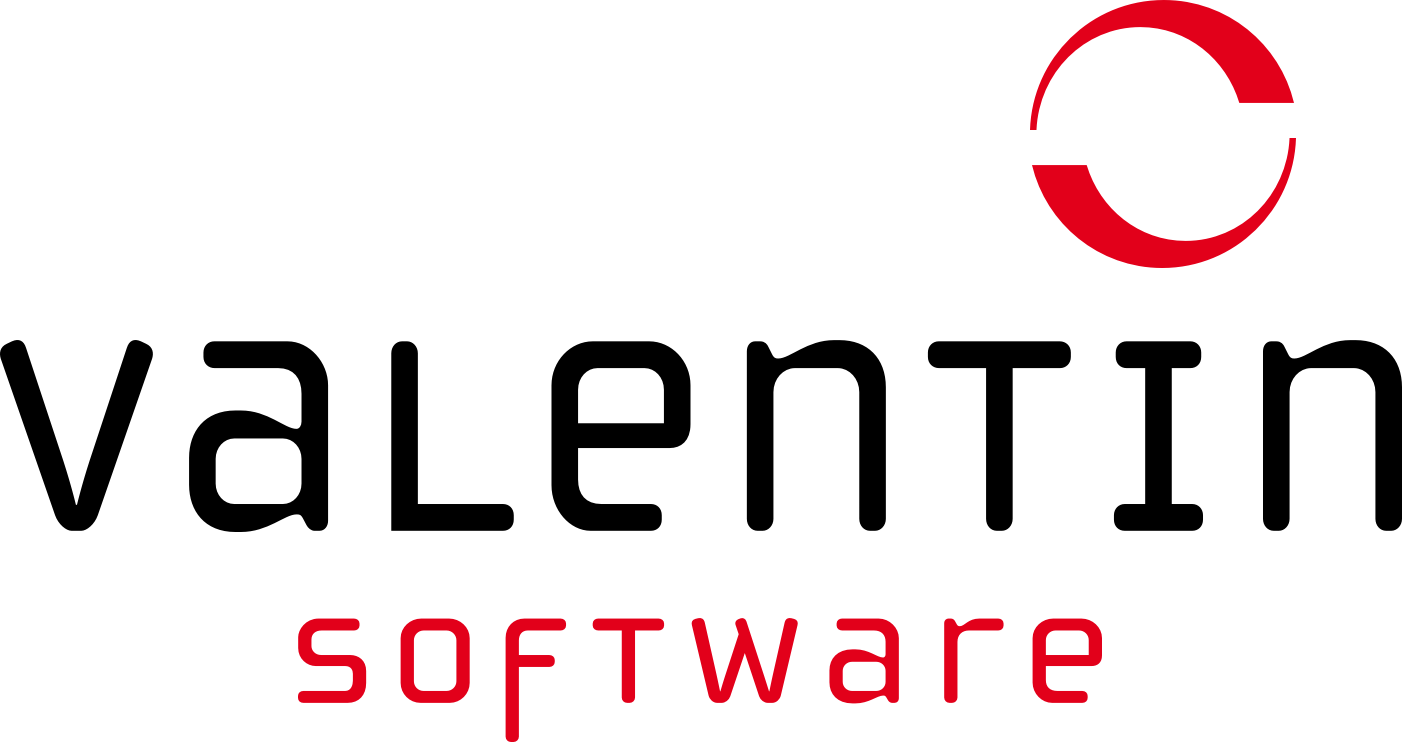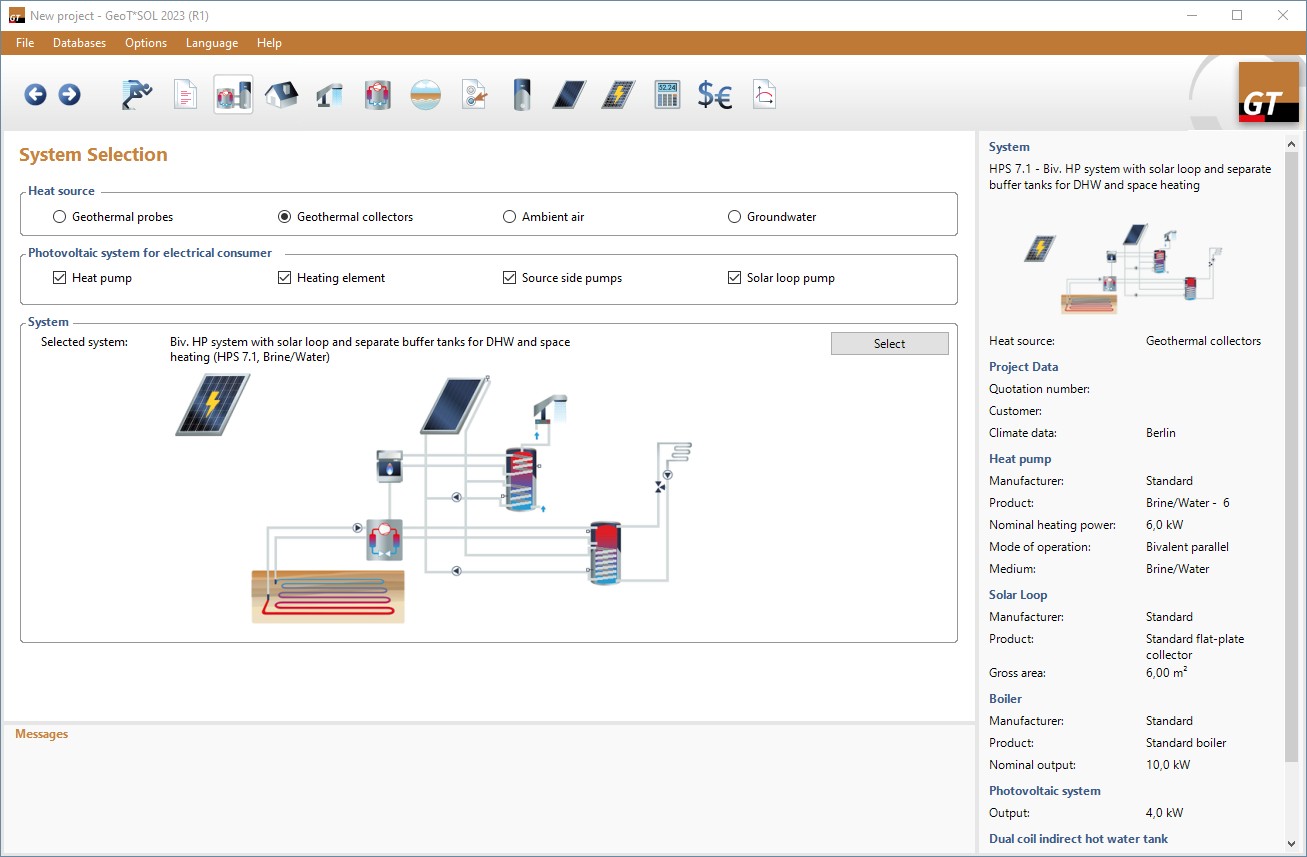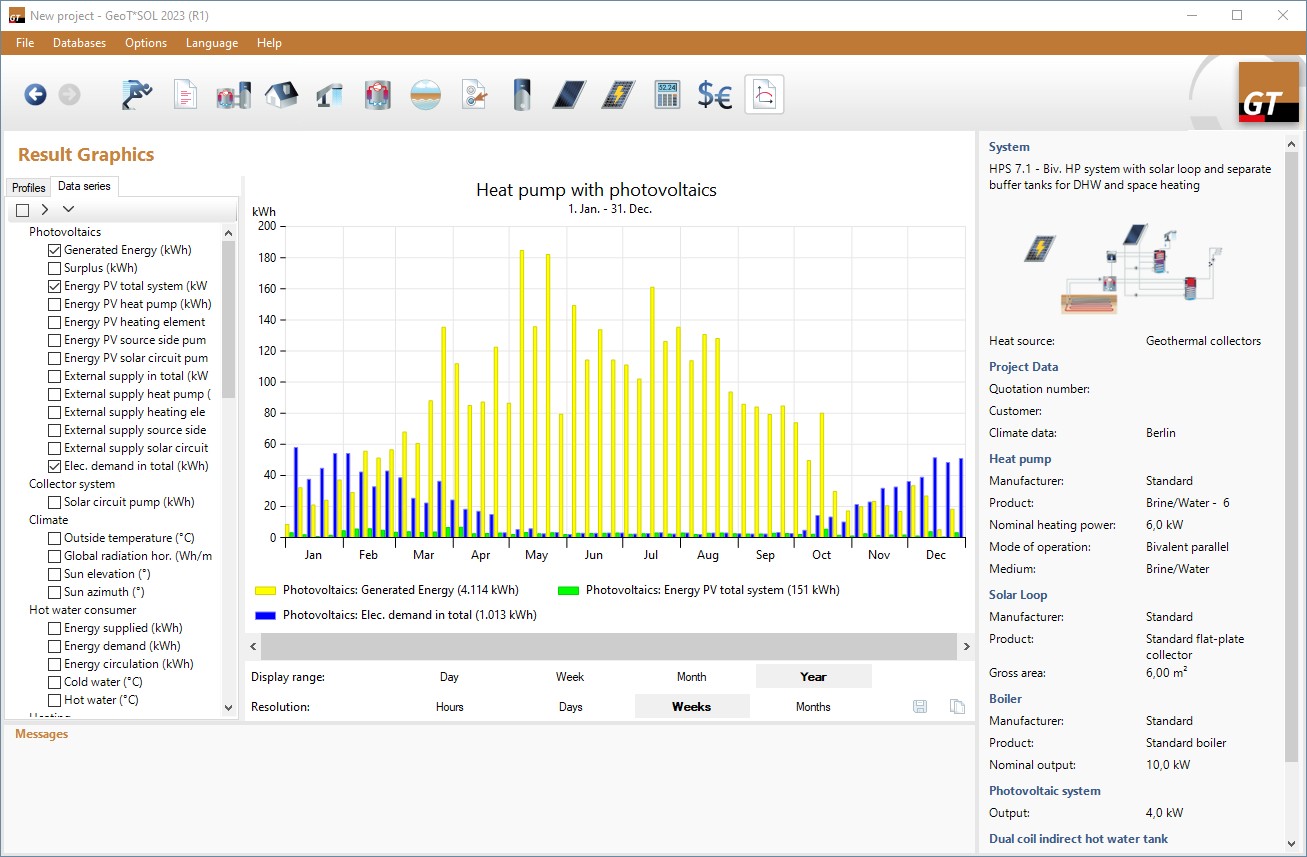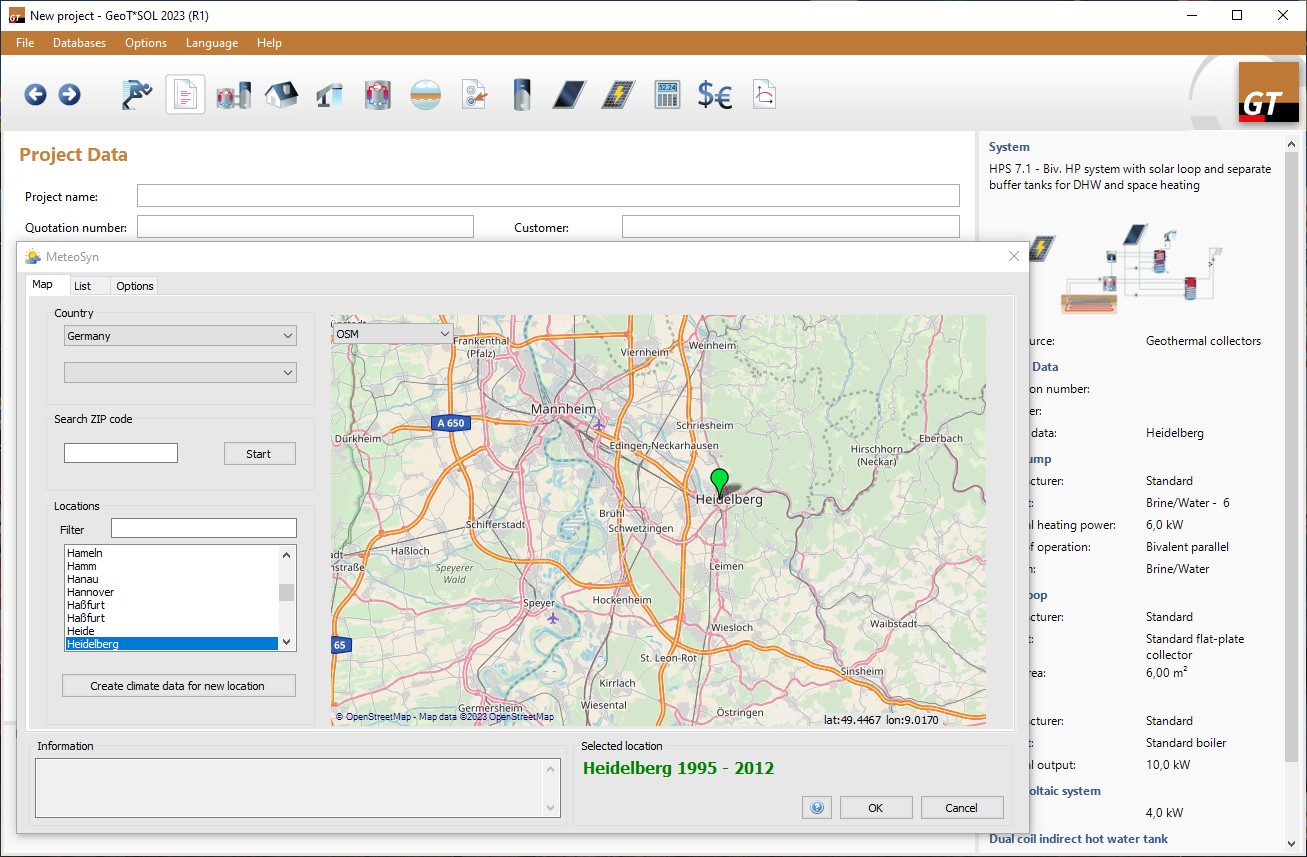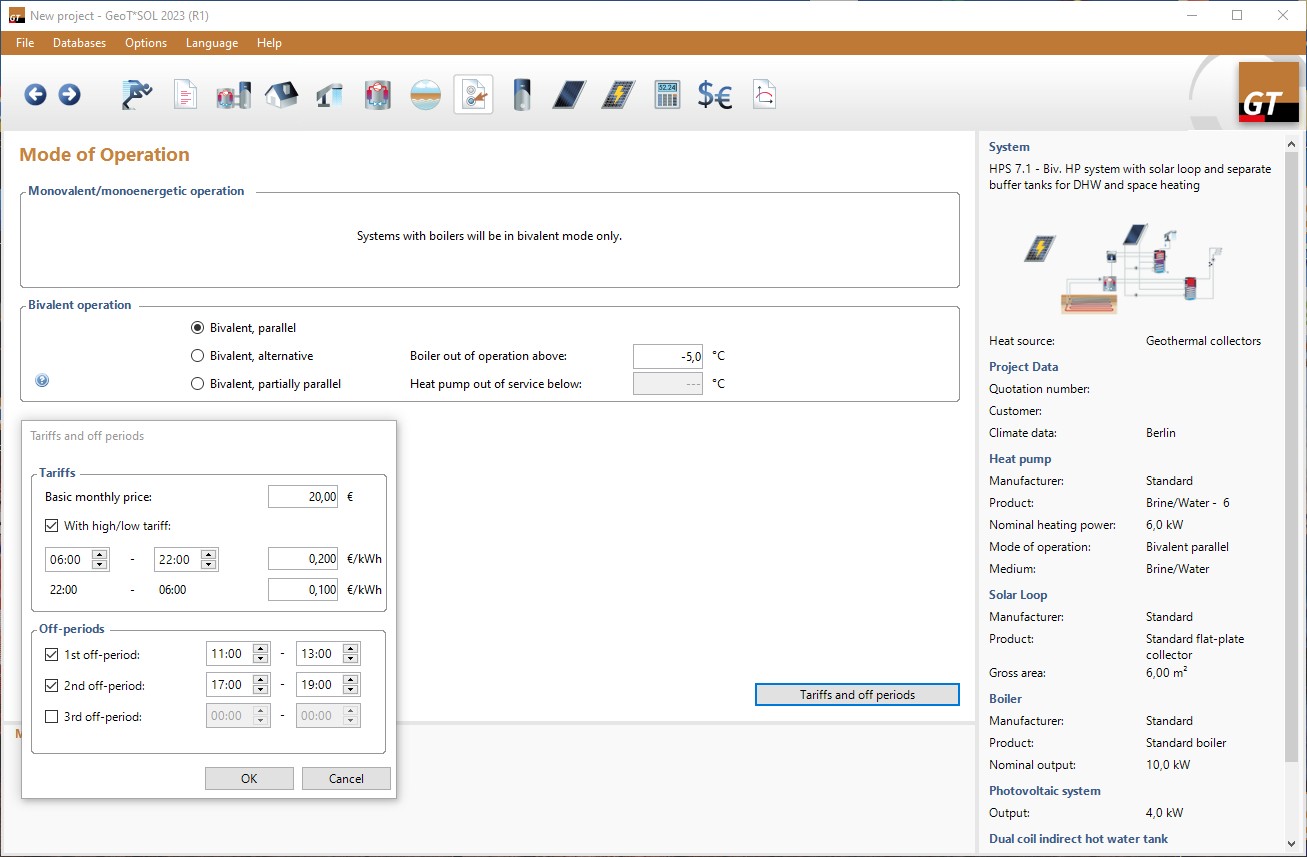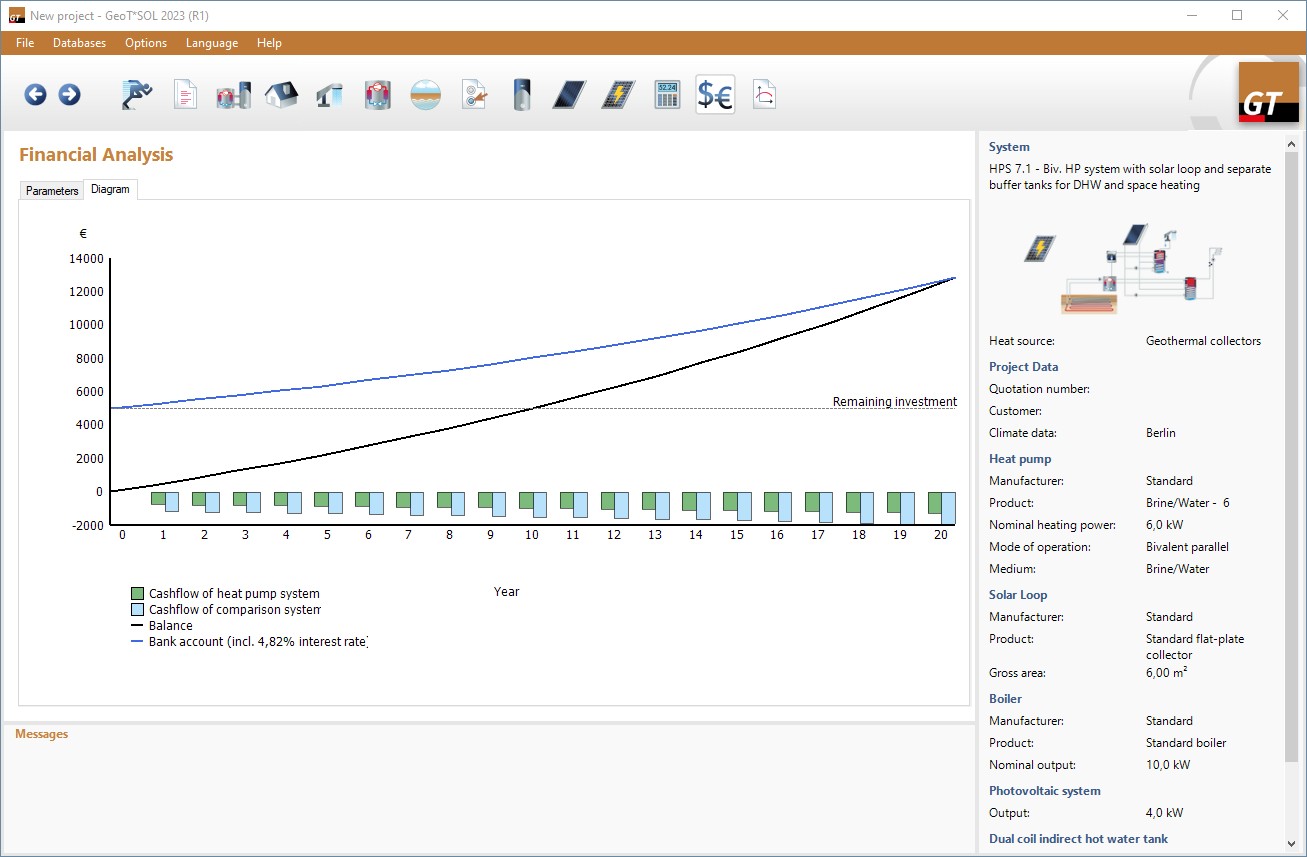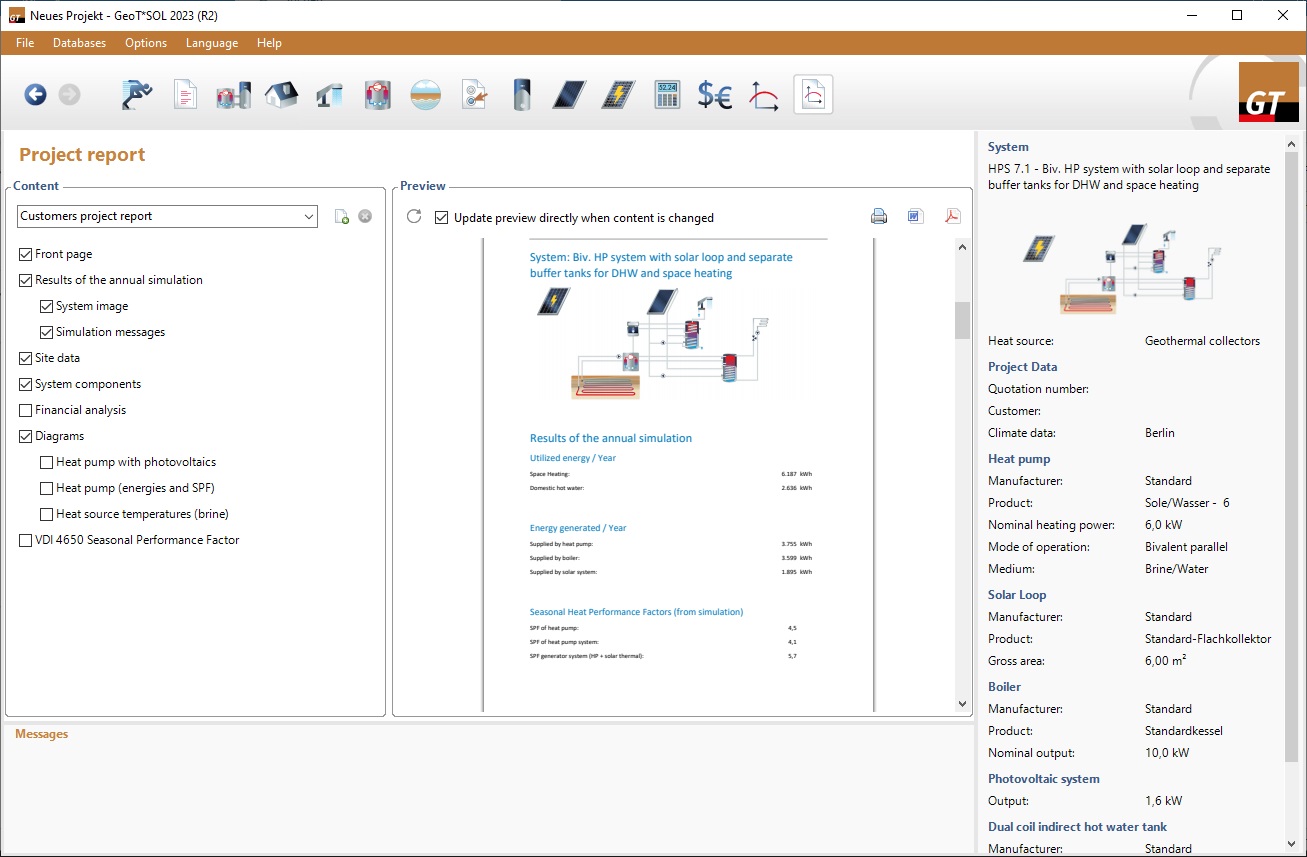GeoT*SOL
Are you looking for a professional and user-friendly software for the planning and design of heat pump systems? Then GeoT*SOL is the ideal tool for you.
GeoT*SOL offers you the choice between different heat sources (soil, air and groundwater), operating modes (monovalent, monoenergetic and bivalent) and numerous system configurations for your location. The program allows for bivalent systems with boiler as heat generator as well as the integration of solar thermal systems and photovoltaic systems.
Based on a dynamic minute simulation, electricity consumption, seasonal performance factors, operating costs and other system data can be calculated, taking into account blocking periods and tariffs. With these parameters, GeoT*SOL helps you to develop efficient and economical heat pump systems. Selected results can be conveniently incorporated into the project report for the client.
GeoT*SOL is available in English , French
and German
. Download your free 30-day trial now!
Product highlights
Heat pump simulation with precise forecasts, integration of further heat generators and PV system
With GeoT*SOL you can simulate the heat pump system to the minute in order to determine seasonal performance factors (SPFs) and contribution margins. Monovalent, monoenergetic and bivalent modes of operation are available for selection. Other heat generators such as gas condensing boilers and solar thermal systems can be added. The integration of a photovoltaic system is also possible.
The seasonal performance factor according to VDI 4650 is an important parameter for comparing systems according to their efficiency. It forms the basis for many funding measures and approval procedures.
Databases with heat pumps, collectors, boilers and storage tanks
GeoT*SOL is delivered with an extensive database. It contains more than
- 6,700 heat pumps (air/water, brine/water, water/water), awarded with KEYMARK certificate
- 4,300 collectors (flat plate collectors, tube collectors, air collectors)
- 5,200 boilers (condensing boilers, wood boilers, pellet boilers, etc.)
- 600 storage tanks (combination and buffer storage, monovalent, bivalent, etc.)
In addition, manufacturers can have additional storage tanks, boilers, collectors and heat pumps added free of charge. Contact: database@valentin-software.com
Dynamic, configurable diagrams
The simulation of the heat pump and PV system provides dozens of simulation results (data series) on an hourly basis. In GeoT*SOL, these can be displayed and evaluated as dynamic, configurable diagrams.
The diagrams can be configured extensively: from the display range (1 day to 1 year) and the resolution (hours to months) of the diagram, to the color and shape (bars, lines, points) of the individual data series. Selected diagrams can be conveniently incorporated into the project report for the client.
More product features
Global climate data available
GeoT*SOL provides you with the latest TMY data of the DWD (current state 2017, averaging period 1995-2012) for Germany and more than 8,000 further climate locations for the whole world based on Meteonorm 8.2. You can use the interactive map to conveniently select the climate data. Locations not included are interpolated using satellite data and neighboring ground measuring stations. The import of your own measurement data takes place via files in DWD, Meteonorm or WBV format.
Profitability analysis
GeoT*SOL calculates the profitability according to the recommendation of the German Solar Association (BSW), taking subsidies into account: Cost comparison of the heat pump system with a reference system; Capital value and production costs (heat price); Modified internal rate of return (MIRR); Profit under consideration of reinvestment.
Configurable project report
Help clients and partners understand the specifics of their heat pump system with appealing reports. The content can range from a short report with seasonal performance factors to a detailed project report with diagrams and system components.
Different project report configurations can be created for different requirements. Changes are immediately displayed in the live preview. The report can be exported as a Word file for further editing or directly as a PDF.
Licensing and pricing
Contact
If you have any questions or need advice, call us on +49 (0) 30 588 439 0 or write an e-mail to sales@valentin-software.com.
We are happy to help you.
GeoT*SOL
Named user license (1 year)
Dynamic simulation program for planning and designing heat pump systems.
385,00 EUR
plus VAT.
System requirements and releases
System requirements
- Internet access
- Processor: Intel i3, AMD Ryzen 3 or higher
- RAM: 2 GB
- Free hard disk space: 1,2 GB
- Resolution display: at least 1280 x 768 pixels, 16 bit
- Operating systems: Windows 10 (64 bit, latest service pack required), Windows 11 (64 bit)
- Miscellaneous: Microsoft .Net Framework 4.8 (will be installed automatically)
You can download our free trial version and test whether GeoT*SOL can be run on your computer!
Release notes
The following bugs have been fixed:
- Program crashed when adopting self-generated climate data outside Germany.
- Crashes when logging in with user-based licensing.
The following new features and changes are included:
- The design temperature is automatically set to the standard outdoor temperature (DIN/TS 12831-1 Part 1: National supplements) for locations in Germany. For all other locations, the coldest temperature from the climate data set is displayed and can be adopted as the design temperature.
- The heating load and domestic hot water energy requirement are displayed in the project status.
- Projects can be loaded, created or the last projects can be opened from the start page.
- Elements can be shown and hidden on the interface to increase clarity.
- Change in display of full load hours: All hours in which the maximum utilisation was reached at least briefly are now counted as full load hours.
- Display of the source temperature for brine heat pumps in the sizing help diagram.
- Project report supplemented with annual domestic hot water energy requirement and design temperature.
- Search in database dialogue improved.
- Databases have been updated.
The following bugs have been fixed:
- Intersection point in sizing help diagram partially incorrect.
- Partial crashes after saving the project report.
- The tank database dialogue also displayed manufacturers that had no tanks.
- In the first simulation, the generator heat output was sometimes not set.
- Changes to the domestic hot water tank of the WPA 8 were not adopted.
The following bugs have been fixed:
- Crash on the page Heat Generator if the supply temperature of the heating system was above 50 °C.
The following new features and changes are included:
- Sizing help for determining the size of heat pump and boiler.
- An RSS feed is now available on the start page of the program.
- Updated product databases.
The following bugs have been fixed:
- Crash when defining a heat pump and entering incorrect values.
- Increasing and decreasing the storage tank temperature with battery system was not possible.
- It was not possible to increase and decrease the storage tank temperature with system HPS 1.1 and HPS 1.2 systems.
The following new features and changes are included:
- New system with space heating and buffer tank (WPA 1.1).
- New bivalent system with space heating, buffer tank and boiler (WPA 1.2).
- New diagrams for visualizing the operating characteristics (energies via temperatures).
- New selection of high and low temperature heating circuits.
- Updated product databases.
- New version of MeteoSyn.
- New license model:
- Dialogs in French.
The following bugs have been fixed:
- After changing self-created heat pumps, the database dialog was not updated.
- Crash when naming self-created heat pumps.
- New license model:
- Crash when starting GeoT*SOL (UUID not available on some computers).
- Crash if the license file could not be written.
- Crash in rare cases where an ini-file contained invalid content.
The following new features and changes are included:
- New license model user-based licenses. More information:
https://valentin-software.com/en/support/faq-new-license-model/
- Access to the database has been accelerated.
The following new features and changes are included:
- Creating and configuring your own heat pumps is now possible again.
- In the simulation results, the degrees of fulfillment of the Gebäudeenergiegesetz (GEG) and Erneuerbare-Wärme-Gesetz (EWärmeG) are now always displayed for system locations in Germany, regardless of the language selection.
- The simulation was accelerated.
- The product database has been updated.
The following new features and changes are included:
- In some cases, it was not possible to access the load profiles of the photovoltaic system.
The following new features and changes are included:
- When selecting a simulation with a photovoltaic system, it is now also possible to simulate with a battery storage system.
- For the simulation with a photovoltaic system, electrical loads can now be taken into account via a load profile.
The following new features and changes are included:
- Calculation of the heating load via building type, year of construction and renovation status or via the annual consumption by entering the energy source, heat generator and consumption. The underlying data is based on the IEE project TABULA.
- Heat pump database based on Keymark test reports and EN 14825. The extensive data covers different climatic conditions and flow temperatures, which enables a more accurate simulation.
- Boiler control in bivalent systems improved.
- Updated calculation of the seasonal performance factor (SPF) in accordance with VDI 4650 Sheet 1 from February 2024.
- Display of full load hours and switch-on processes of the heat pump, these provide indications of oversizing or undersizing of the heat pump.
- Climate data updated, based on Meteonorm 8.2 (climate data period 2001 - 2020).
- Adaptation to the GEG (German Buildings Energy Act) of January 1, 2024 and display of the shares of heat generation according to § 71 for heat pumps and solar thermal systems.
- Adaptation to the EWärmeG (Baden-Württemberg) from February 10, 2023.
The following bugs have been fixed:
- Incorrect supply and return temperatures of the boiler in the results graphs.
- Project data of the heat source and the heating element were not loaded.
- Energy generated by the photovoltaic system was not included in CO2 emissions.
- Orientation of the collectors in the southern hemisphere was incorrect.
- Sensor heights of heating buffer tank with heat exchanger corrected.
- In some cases, the heating element was in operation even though it was not needed.
- Creation of locations via MeteoSyn sometimes not possible.
- Selection of the printer sometimes did not work.
Contact
![]()
Sales
For product inquiries or questions regarding your order, quote, or invoice, please get in touch with our sales team:
E-mail: sales@valentin-software.com
Telephone: +49 (0)30 588 439 0
Office hours:
Mon – Thu, 9:00 – 16:00 hrs
Fri, 9:00 – 13:00 hrs
![]()
Technical support
Do you have any questions about installation, registration, project-related topics, or our online databases? Our technical support team is here to help:
E-mail: hotline@valentin-software.com
Telephone: +49 (0)30 588 439 0
Office hours:
Mon – Thu, 9:00 – 12:00 hrs and 13:00 – 15:00 hrs
Fri, 9:00 – 12:00 hrs
Visit our Forum and our PV*SOL help pages
